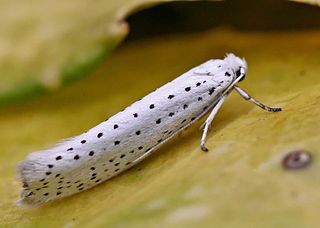
The family Yponomeutidae are known as the ermine moths, with several hundred species, most of them in the tropics. The larvae tend to form communal webs, and some are minor pests in agriculture, forestry, and horticulture. Adult moths are minor pollinators.

Pinus pumila, commonly known as the Siberian dwarf pine, dwarf Siberian pine, dwarf stone pine, Japanese stone pine, or creeping pine, is a tree in the family Pinaceae native to northeastern Asia and the Japanese isles. It shares the common name creeping pine with several other plants.

Zamia pumila, commonly known as guáyara in Spanish, is a small, tough, woody cycad native to the Greater Antilles. Z. pumila was the first species described for the genus and, therefore, is the type species for the genus Zamia and the family Zamiaceae.

Ulmus pumila, the Siberian elm, is a tree native to Asia. It is also known as the Asiatic elm and dwarf elm, but sometimes miscalled the 'Chinese elm'. U. pumila has been widely cultivated throughout Asia, North America, Argentina, and southern Europe, becoming naturalized in many places, notably across much of the United States.

Ficus pumila, commonly known as the creeping fig or climbing fig, is a species of flowering plant in the mulberry family, native to East Asia and naturalized in parts of the southeastern and south-central United States. It is also found in cultivation as a houseplant. The Latin specific epithet pumila means "dwarf", and refers to the very small leaves of the plant.
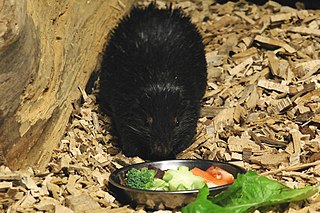
The Philippine porcupine or Palawan porcupine is a species of rodent in the family Hystricidae endemic to the island of Palawan in the Philippines. It is known locally as durian or landak.

Antimima is a succulent plant genus in the family Aizoaceae, indigenous to South Africa and Namibia.
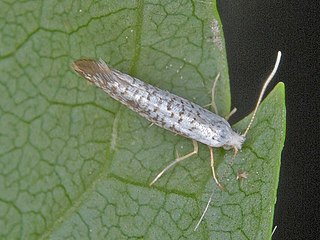
Argyresthia retinella is a species of moth of the family Yponomeutidae.

Eucalantica is a genus of moths of the family Yponomeutidae. Species in the genus are superficially similar to Thecobathra species, which also have a silvery white body and forewings, but differ from the latter in having a dark brown costal streak in forewing.
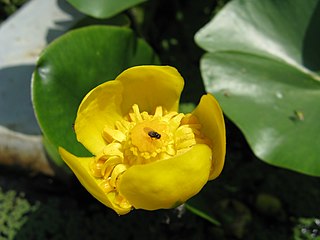
Nuphar pumila, the least water-lily or small yellow pond-lily, is an aquatic perennial plant in the Nymphaeaceae family. It is also known as the dwarf water lily since it looks like a smaller Nuphar lutea. while Nuphar pumila has a star-shaped, or lobed form of the stigma disc and glabrous leaf undersides, Nuphar lutea has a round stigma disc and the undersides of its leaves are occasionally fine-haired on the midribs. Its flowers bloom from July to August and are typically pollinated by flies.

Eucalantica polita is a moth in the family Yponomeutidae. It is found at the Pacific side of the coastal regions of Canada and the United States.

Eucalantica costaricae is a moth in the family Yponomeutidae. It is found in Costa Rica.
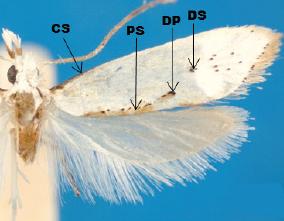
Eucalantica ehecatlella is a moth in the family Yponomeutidae. It is found in Costa Rica.

Eucalantica icarusella is a moth in the family Yponomeutidae. It is found in Costa Rica.
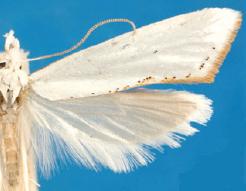
Eucalantica powelli is a moth in the family Yponomeutidae. It is found in Costa Rica.

Eucalantica vaquero is a moth in the family Yponomeutidae. It is found in the United States and Mexico.

Iris attica, the Greek iris, is a plant species in the genus Iris, it is also in the subgenus Iris. It is a rhizomatous perennial, from the mountains of the Balkans in Europe, within the countries of Greece, former Yugoslavia, Turkey and North Macedonia. It has sage green or grey-green leaves, that are sickle-shaped, a stout short stem and 2 variable flowers, in shades from yellow to purple. They have a white or blue beard. It is often called Iris pumila subsp attica, but is classified in most sources, as a separate species, although it is closely related to Iris pumila, as a possible parent plant. It is cultivated as an ornamental plant in temperate regions.

Tulista pumila ("Vratjiesaalwee") is a species of Tulista succulent plant, from the Western Cape, South Africa.
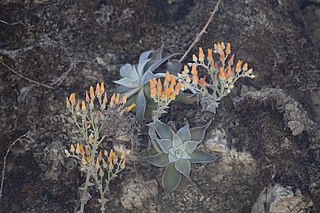
Dudleya cymosasubsp. pumila, most commonly known as the low canyon dudleya, chalky canyon dudleya or California live-forever, is a species of perennial succulent plant. It has diamond to spoon shaped leaves, sometimes coated with a fine white powder, and in May through July, bright red, orange or yellow flowers adorn the short inflorescence. A leaf succulent primarily found growing in rocky cliffs and slopes, it is endemic to California, and grows in the Transverse Ranges and South Coast Ranges, with some outlying populations. A variable plant, in some localities it is difficult to distinguish from other plants in the genus.












